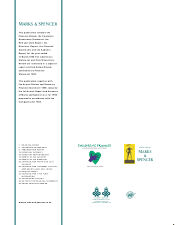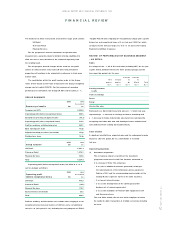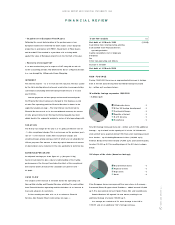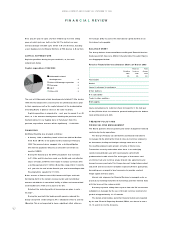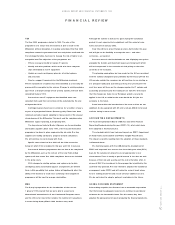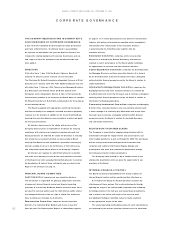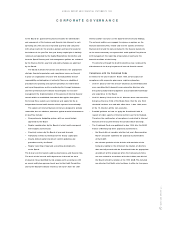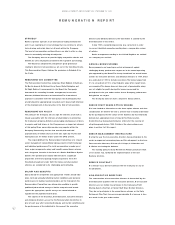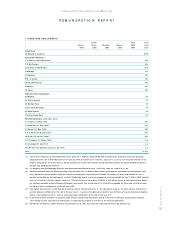Marks and Spencer 1999 Annual Report Download - page 8
Download and view the complete annual report
Please find page 8 of the 1999 Marks and Spencer annual report below. You can navigate through the pages in the report by either clicking on the pages listed below, or by using the keyword search tool below to find specific information within the annual report.
6
CO RPO RATE GO VERN AN CE
THE COMPANY BELIEVES IN AND IS COMMITTED TO
HIGH STANDARDS OF CORPORATE GOVERNANCE.
In June 1998 the Combined Code:Principles of Good Governance
and Code of Best Practice (“Combined Code”) was published.
As reported to shareholders last year, the Board of directors has
reviewed its existing standards of Corporate Governance and can
now report on how the principles in the Combined Code have
been applied:
DIRECTORS
W ith effect from 1 June 1999 the Marks & Spencer Board will
comprise 16 directors, seven of whom are non-executive.
The Chairman, Sir Richard Greenbury, relinquished the post of Chief
Executive on 31 January 1999 with Peter Salsbury taking on that role
with effect from 1 February 1999.There are two Managing Directors,
Guy McCracken and Andrew Stone. Sir Martin Jacomb is the
Company’s senior independent director. In view of their previously
held executive positions in the Company the Board does not consider
Sir Richard Greenbury or David Sieff as independent for the purposes
of the Combined Code.
The Board is supplied with appropriate and timely information
and meets monthly. It has adopted a schedule of matters specifically
reserved to it for decision. In addition to the formal monthly Board
meetings, the executive directors meet weekly to monitor and guide
the Group’s performance.
All directors have access to the advice and services of the
Company Secretary, who is responsible to the Board for ensuring
compliance with statutory and regulatory requirements and that
board procedures are followed. He assists the Chairman in ensuring
that all directors are properly briefed on issues arising at Board
meetings.The Board has also established a procedure whereby any
directors, wishing to do so in the furtherance of their duties, may
take independent professional advice at the Company’s expense.
All directors are required to submit themselves for re-election
and under the Company’s current Articles of Association, one-third
of the Board must retire annually, offering themselves for re-election
by shareholders. Details of those retiring this year are given in the
Report of the D irectors on page 19.
PRINCIPAL BOARD COMMITTEES
Audit Committee: comprises six non-executive directors.
The Committee is responsible for giving an independent overview
of systems of internal financial control and financial reporting
processes. It is chaired by Sir Martin Jacomb and meets three times
per year.The external auditors and the chief internal auditor attend
all meetings. All directors have the right to attend.The minutes of
these meetings are circulated to all directors.
Remuneration Committee: comprises five non-executive
directors. It is chaired by Brian Baldock and meets at least four
times per year. The Remuneration Report to shareholders appears
on pages 8 to 15 which gives details of each director’s remuneration
together with policy and procedures regarding senior management
remuneration.The remuneration of non-executive directors
is determined by the Chief Executive together with the
executive directors.
Nomination Committee: comprises all the non-executive
directors. It is chaired by Sir Richard Greenbury and meets as
required to select and propose to the Board suitable candidates
for appointment as executive and non-executive directors.
Capital Expenditure Committee: comprises the Chief Executive,
the Managing Directors and three executive directors. It is chaired
by the Chief Executive and meets monthly. It exercises a delegated
authority within financial parameters set by the Board in relation to
capital expenditure.
Information Technology Review Committee: comprises the
Managing Directors and three executive directors. It is chaired by
Guy McCracken and meets five times per year. It exercises a delegated
authority within financial parameters set by the Board in relation to
information technology expenditure.
Community Involvement Committee: comprises one Managing
D irector, three executive directors, two non-executive directors and
a senior manager. It is chaired by Guy McCracken and meets three
times per year. It exercises a delegated authority within financial
parameters set by the Board in relation to charitable donations
and community involvement.
RELATIONS W ITH SHAREHOLDERS
The Company is committed to ongoing communication with its
shareholders through the regular interim and annual reports and
other trading statements, as well as through the AGM.The Company’s
website at http://www.marks-and-spencer.co.uk contains both
corporate and customer information. Regular dialogue and
presentations take place with institutional shareholders through
the Company’s investor relations programme.
The Company holds its AGM in July in London which is well
attended by shareholders who are given the opportunity to ask
questions of the Board.
INTERN AL FINANCIAL CONTROL
The Board has overall responsibility for the Group’s systems of
internal financial control and for monitoring their effectiveness.
O n behalf of the Board, the Audit Committee examines the
effectiveness of these systems.This is achieved primarily through
agreeing the scope of the internal audit programme and reviewing
its findings, reviews of the half year and annual financial statements,
and a review of the nature and scope of the external audit.
Any significant findings or identified risks are closely examined
so that appropriate action can be taken.
The annual operating and budgetary plans for each operating area
are reviewed by the relevant executive directors prior to submission
ANNUAL REPORT AND FIN ANCIAL STATEMENTS 1999


